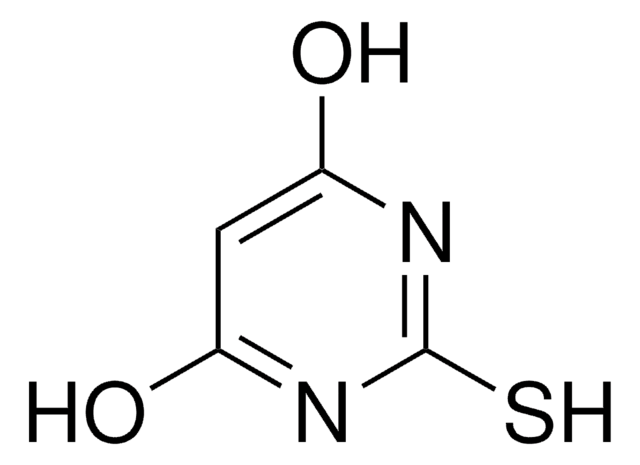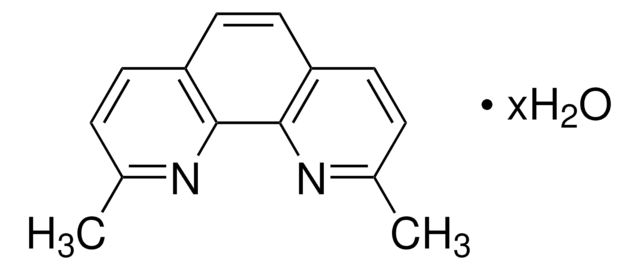404888
1-Methyl-2-phenylindole
99%
Synonym(s):
NSC 63793
Sign Into View Organizational & Contract Pricing
All Photos(1)
About This Item
Empirical Formula (Hill Notation):
C15H13N
CAS Number:
Molecular Weight:
207.27
EC Number:
MDL number:
UNSPSC Code:
12352100
PubChem Substance ID:
NACRES:
NA.22
Recommended Products
Quality Level
Assay
99%
mp
98-100 °C (lit.)
functional group
phenyl
SMILES string
Cn1c(cc2ccccc12)-c3ccccc3
InChI
1S/C15H13N/c1-16-14-10-6-5-9-13(14)11-15(16)12-7-3-2-4-8-12/h2-11H,1H3
InChI key
SFWZZSXCWQTORH-UHFFFAOYSA-N
Looking for similar products? Visit Product Comparison Guide
General description
Reaction of 1-methyl-2-phenylindole with nitrogen dioxide or with nitrous acid (NaNO2-CH3COOH) in benzene has been studied. 1-Methyl-2-phenylindole is reported to react with malondialdehyde (MDA) and 4-hydroxyalkenals to afford a stable chromophore with intense maximal absorbance at 586nm.
Application
1-Methyl-2-phenylindole may be used in the following studies:
- The estimation of lipid peroxidation in third instar larvae of transgenic Drosophila melanogaster (hsp70-lacZ)Bg.
- As chromogenic agent for the determination of estimation of malondialdehyde (MDA) production.
- Colorimetric assay of lipid peroxidation.
- Synthesis of 1-methyl-2-phenyl-3-(1,3,4-thiadiazol-2-yldiazenyl)-1H-indole.
- Synthesis of 3-(5-ethyl-1,3,4-thiadiazol-2-yldiazenyl)-1-methyl-2-phenyl-1H-indole.
Reactant for preparation of:
Reactant for:
- Cyano indoles
- Difluorohydroxy indoles
Reactant for:
- Carboxylation of indoles
- Allylation of indoles
- Formylation of indoles
- Nitrosylation of indoles
Signal Word
Warning
Hazard Statements
Precautionary Statements
Hazard Classifications
Eye Irrit. 2 - Skin Irrit. 2 - STOT SE 3
Target Organs
Respiratory system
Storage Class Code
11 - Combustible Solids
WGK
WGK 3
Flash Point(F)
Not applicable
Flash Point(C)
Not applicable
Choose from one of the most recent versions:
Already Own This Product?
Find documentation for the products that you have recently purchased in the Document Library.
Customers Also Viewed
M E Nieves-Ramírez et al.
mSystems, 3(3) (2018-07-03)
Blastocystis is the most prevalent protist of the human intestine, colonizing approximately 20% of the North American population and up to 100% in some nonindustrialized settings. Blastocystis is associated with gastrointestinal and systemic disease but can also be an asymptomatic
Yasir Hasan Siddique et al.
Dose-response : a publication of International Hormesis Society, 10(1), 1-10 (2012-03-17)
Malondialdehyde (MDA) is used for the estimation of damage by reactive oxygen species. MDA is a major reactive aldehyde resulting from the peroxidation of biological membranes. The most common method used to assess MDA production is the thiobarbituric acid (TBARS)
Yasir Hasan Siddique et al.
Pharmaceutical methods, 3(2), 94-97 (2013-06-20)
A method using 1-methyl-2-phenylindole was developed for the estimation of lipid peroxidation in third instar larvae of transgenic Drosophila melanogaster (hsp70-lacZ)Bg (9). The method is specific for the estimation of malonaldehyde. The larvae were exposed to 0.0025, 0.025, 0.050, and
Marcin Magierowski et al.
Journal of gastroenterology, 53(1), 52-63 (2017-02-27)
Aspirin exerts side effects within the gastrointestinal tract. Hydrogen sulfide (H Wistar rats with or without capsaicin-induced denervation of sensory neurons were pretreated with vehicle, CORM-2 (5 mg/kg intragastrically), or NaHS (5 mg/kg intragastrically) with or without capsazepine (5 mg/kg intragastrically) or N
D Gérard-Monnier et al.
Chemical research in toxicology, 11(10), 1176-1183 (1998-10-20)
Under acidic and mild-temperature conditions, 1-methyl-2-phenylindole was found to react with malondialdehyde (MDA) and 4-hydroxyalkenals to yield a stable chromophore with intense maximal absorbance at 586 nm. The use of methanesulfonic acid results in optimal yields of chromophore produced from
Our team of scientists has experience in all areas of research including Life Science, Material Science, Chemical Synthesis, Chromatography, Analytical and many others.
Contact Technical Service










